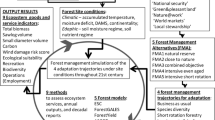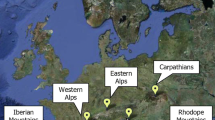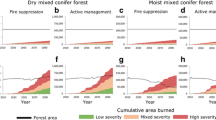Abstract
In regions prone to wildfire, a major driver of ecosystem change is increased frequency and intensity of fire events caused by a warming, drying climate. Uncertainty over the nature and extent of change creates challenges for how to manage ecosystems subject to altered structure and function under climate change. Using montane forests in south-eastern Australia as a case study, we addressed this issue by developing an ecosystem state-and-transition model based on a synthesis of expert knowledge and published data, with fire frequency and intensity as drivers. We then used four steps to determine future adaptation options: (1) estimation of changes in ecosystem services under each ecosystem state to identify adaptation services: the ecosystem processes and services that help people adapt to environmental change; (2) identification and sequencing of decision points to maintain each ecosystem state or allow transition to an alternative state; (3) analysis of interactions between societal values, scientific and management knowledge and institutional rules (vrk) required to reframe the decision context for future management, and (4) determining options for an adaptation pathway for management of montane forests under climate change. Our approach is transferable to other ecosystems for which alternative states can be predicted under climate change.



Similar content being viewed by others
References
Ashton DH, Attiwill PM (1994) Tall open-forests. In: Groves RH (ed) Australian vegetation, 2nd edn. Cambridge University Press, Cambridge, pp. 157–196
Attiwill PM, Ryan MF, Burrows N, Cheney NP, McCaw L, Neyland M, Read S (2014) Timber harvesting does not increase fire risk and severity in wet eucalypt forest of southern Australia. Conserv Lett 7:341–354
Barnett J, O’Neill S (2010) Maladaptation. Glob Environ Chang 20:211–213
Bassett OD, Prior LD, Slijkerman CM, Jamieson D, Bowman DMJS (2015) Aerial sowing stopped the loss of alpine ash (Eucalyptus delegatensis) forests burnt by three short-interval fires in the Alpine National Park, Victoria, Australia. For Ecol Manag 342:39–48
Benyon R, Haydon S, Vertessy RA, Hatton T, Kuczera G, Feikema P, Lane PNJ (2010) Comment on Wood et al. 2008, ‘Impacts of fire on forest age and runoff in mountain ash forests’. Funct Plant Biol 37:1187–1191
Bowman DMJS, Wood SW, Neyland DLJ, Sanders GJ, Prior LD (2013a) Contracting Tasmanian montane grasslands within a forest matrix is consistemt with cessation of Aboriginal fire management. Austral Ecol 38:627–638
Bowman DMJS, Murphy BP, Boer MM, et al. (2013b) Forest fire management, climate change and the risk of catastrophic carbon losses. Front Ecol Environ 11:66–67
Bowman DMJS, Murphy BP, Neyland DLJ, Williamson GJ, Prior LD (2014) Abrupt fire regime change may cause landscape-wide loss of mature obligate seeder forests. Glob Chang Biol 20:1008–1015
Bradstock RA (2010) A biogeographic model of fire regimes in Australia: current and future implications. Glob Ecol Biogeogr:19145–19158
Bren L (2015) Forest hydrology and catchment management: an Australian perspective. Springer, Dordrecht
Briske DD, Fuhlendorf SD, Smeins FE (2005) State-and-transition models, thresholds, and rangeland health: a synthesis of ecological concepts and perspectives. Rangel Ecol Manag 58:1–10
Campbell PL, Kluge RL (1999) Development of integrated control strategies for wattle. 1. Utilization of wattle, control of stumps and rehabilitation with pastures. S Afr J Plant Soil 16:24–30
Chiew FHS (2006) Estimation of rainfall elasticity of streamflow in Australia. Hydrol Sci J 51:613–625
Clarke HG, Smith PL, Pitman AJ (2011) Regional signatures of future fire weather over eastern Australia from global climate models. Int J Wildland Fire 20:550–562
Clarke PJ, Lawes MJ, Midgley JJ, et al. (2013) Resprouting as a key functional trait: how buds, protection and resources drive persistence after fire. New Phytol 197:19–35
Colloff MJ, Lavorel S, Wise RM, Dunlop M, Overton IC, Williams KJ (2016) Adaptation services of floodplains and wetlands under transformational climate change. Ecol Appl 26:1003–1017
Cremer KW, Cromer RN, Florence RG (1984) Stand establishment. In: Hillis WE, Brown AG (eds) Eucalypts for wood production. CSIRO Publishing, Melbourne and Academic Press, Sydney, pp. 81–135
CSIRO, BoM (2015) Climate change in Australia: information for Australia’s natural resource management regions. CSIRO Canberra and Bureau of Meteorology, Melbourne
DEPI (2015) Bushfire History. Department of Environment and Primary Industries, Melbourne. http://www.depi.vic.gov.au/fire-and-emergencies/managing-risk-and-learning-about-managing-fire/bushfire-history. Accessed 17 Sep 2015
Enright NJ, Fontaine JB, Bowman DMJS, Bradstock R, Williams RJ (2015) Interval squeeze: altered fire regimes and demographic responses interact to threaten woody species persistence as climate changes. Front Ecol Environ 13:265–272
Fagg P, Lutze M, Slijkerman C, Ryan M, Bassett O (2013) Silvicultural recovery in ash forests following three recent large bushfires in Victoria. Aust For 76:140–155
Fairman TA, Nitschke CR, Bennett LT (2015) Too much, too soon? A review of the effects of increasing wildfire frequency on tree mortality and regeneration in temperate eucalypt forests. Int J Wildland Fire. doi:10.1071/WF15010
Ferguson I, Cheney P (2011) Wildfires, not logging, cause landscape traps. Aust For 74:362–365
Flint A, Fagg P (2007) Mountain ash in Victoria’s state forests. Victorian Government Department of Sustainability and Environment, Melbourne
Folke C, Carpenter S, Walker B, Scheffer M, Elmqvist T, Gunderson L, Holling CS (2004) Regime shifts, resilience, and biodiversity in ecosystem management. Annu Rev Ecol Evol Syst 35:557–581
Gellie NJH (2005) Native vegetation of the southern forests: south-east highlands, Australian Alps, south-west slopes, and SE corner bioregions. Cunninghamia 9:219–254
Gharun M, Turnbull TL, Adams MA (2013) Stand water use status in relation to fire in a mixed species eucalypt forest. For Ecol Manag 30:162–170
Gill AM (1975) Fire and the Australian flora: a review. Aust For 38:4–25
Gorddard R, Wise RM, Ware D, Dunlop M, Colloff MJ (2016) Values, rules and knowledge: adaptation as change in the decision context. Environ Sci Pol 57:60–69
Griffiths T (2001) Forests of ash. An environmental history. Cambridge University Press, Cambridge
IPCC (2014) Climate change 2014 synthesis report. Summary for policymakers. Cambridge University Press, Cambridge
Kanowski P (2015) Australia’s forests: contested past, tenure-driven present, uncertain future. Forest Policy Econ. doi:10.1016/j.forpol.2015.06.001
Keith DA (2006) Ocean shores to desert dunes: the native vegetation of New South Wales and the ACT. Department of Environment and Conservation New South Wales, Sydney
Keith DA (2012) Functional traits: their role in understanding and predicting biotic responses to fire regimes from individuals to landscapes. In: Bradstock RA, Gill AM, Williams RJ (eds) Flammable Australia: fire regimes. Biodiversity and Ecosystems in a Changing World. CSIRO Publishing, Melbourne, pp. 97–125
Keith H, Mackey BG, Lindenmayer DB (2009) Re-evaluation of forest biomass carbon stocks and lessons from the world's most carbon-dense forests. Proc Natl Acad Sci U S A 106:1–6
Lavorel S, Colloff MJ, McIntyre S, et al. (2015) Ecological mechanisms underpinning climate adaptation services. Glob Chang Biol 21:12–31
Leonard SWJ, Bennett AF, Clarke MF (2014) Determinants of the occurrence of unburnt forest patches: potential biotic refuges within a large, intense wildfire in south-eastern Australia. For Ecol Manag 314:85–93
Lindenmayer DB, Cunningham RB, Donnelly CF, Franklin JF (2000) Structural features of old-growth Australian montane ash forests. For Ecol Manag 134:189–204
Lindenmayer DB, Hobbs RJ, Likens GE, Krebs CJ, Banks SC (2011) Newly discovered landscape traps produce regime shifts in wet forests. Proc Natl Acad Sci U S A 108:15887–15891
McCarthy MA, Gill AM, Lindenmayer DB (1999) Fire regimes in mountain ash forest: evidence from forest age structure, extinction models and wildlife habitat. For Ecol Manag 124:193–203
Michael DR, Cunningham RB, Lindenmayer DB (2011) Regrowth and revegetation in temperate Australia presents a conservation challenge for reptile fauna in agricultural landscapes. Biol Conserv 144:407–415
Mok H-F, Arndt SK, Nitschke CR (2012) Modelling the potential impacts of climate variability and change on species regeneration potential in the temperate forests of south-eastern Australia. Glob Chang Biol 18:1053–1072
Moritz MA, Batllori E, Gill AM, et al. (2014) Learning to coexist with wildfire. Nature 515:58–66
Nolan RH, Lane PNJ, Benyon RG, Bradstock RA, Mitchell PJ (2015) Trends in evapotranspiration and streamflow following wildfire in resprouting eucalypt forests. J Hydrol 524:614–624
Prober SM, Stol J, Piper M, Gupta VVSR, Cunningham SA (2014) Towards climate-resilient restoration in mesic eucalypt woodlands: characterising topsoil biophysical condition in different degradation states. Plant Soil 383:231–244
Ryan M (2013) Adaptive silviculture in regrowth eucalypt forests in Victoria and the implications for water, wood, wildlife and wildfire. Aust For 76:173–182
Stephens SL, Agee JK, Fule PZ, North MP, Romme WH, Swetnam TW (2013) Managing forests and fire in changing climates. Science 342:41–42
Thom D, Seidl R (2015) Natural disturbance impacts on ecosystem services and biodiversity in temperate and boreal forests. Biol Rev Camb Philos Soc. doi:10.1111/brv.12193
Timbal B, Abbs D, Bhend J, et al. (2015) Murray Basin cluster report: climate change in Australia: projections for Australia’s natural resource management regions. CSIRO, Canberra and Bureau of Meteorology, Melbourne
Vankat JL (2013) Vegetation dynamics on the mountains and plateaus of the American southwest. Springer, New York
Vertessy RA, Watson FGR, O’Sullivan SK (2001) Factors determining relations between stand age and catchment water balance in mountain ash forests. For Ecol Manag 143:13–26
Wise RM, Fazey I, Stafford Smith M, Park S, Eakin H, Archer Van Garderen E, Campbell B (2014) Reconceptualising adaptation to climate change as part of pathways of change and response. Glob Environ Chang 28:325–336
Zhang L, Dawes WR, Walker GR (2001) Response of mean annual evapotranspiration to vegetation changes at catchment scale. Water Resour Res 37:701–708
Acknowledgments
This research was funded by CSIRO Land and Water and contributes to OPERAs FP7-ENV-2012-two-stage-308393, the Transformative Adaptation Research Alliance (TARA) and the CSIRO Enabling Adaptation Pathways Project (EAP). Sandra Lavorel acknowledges funding from the CSIRO Distinguished Visiting Scientist Program. We thank Drs Saul Cunningham and Helen Murphy (CSIRO Land and Water) for their constructive reviews of the manuscript.
Author information
Authors and Affiliations
Corresponding author
Electronic supplementary material
ESM 1
(DOCX 2910 kb)
Rights and permissions
About this article
Cite this article
Colloff, M.J., Doherty, M.D., Lavorel, S. et al. Adaptation services and pathways for the management of temperate montane forests under transformational climate change. Climatic Change 138, 267–282 (2016). https://doi.org/10.1007/s10584-016-1724-z
Received:
Accepted:
Published:
Issue Date:
DOI: https://doi.org/10.1007/s10584-016-1724-z




